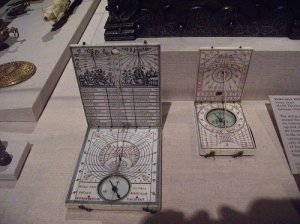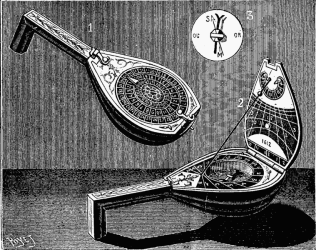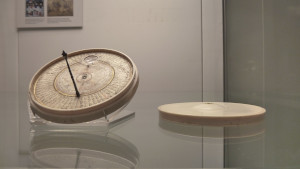Medieval Baltic


Medieval Europe
The Role of Portable Sundials in Arabic and European medieval astronomy.
An abridged version of this essay appeared in issue 35 of the SCA magazine Cockatrice.
The different roles and uses of Arabic and European astronomical instruments have often been typified through comparative studies of astrolabes and cross-staffs, however the focus of this essay shall be something much simpler, the sundial. The sundial is an instrument that can be found in numerous contexts, as functional decoration on the side of a building, to personal, pocket-sized devices carried in the pocket of an individual. It is the personal use of sundials, and their role in both Arabic and European medieval to renaissance societies, that shall be explored.
Firstly, it should be clarified that the sundial in an astronomical context is not merely a primitive clock or time-telling device. It is considered within this essay to be an ‘astronomical instrument which enables the time to be determined from the apparent motion of the sun' (Daniel, 2000). These measurements of the suns’ apparent motion can be calculated through marking equal divisions upon a surface that a shadow is cast by a gnomon. These markings could be the hours of the day, the times for prayer or simply an indicator of the time before, or after, midday.
Within the large corpus of sundials, those designed for personal use have similar owners in Arabic and European societies; however their roles are quite divergent. Instead of public sundials, designed for the benefit of an entire village or town, personal sundials reflect the role that time measurement played for their owners. It shall be seen that the use of astronomical time-keeping instruments remained an important part of medieval Islamic culture, while in Europe, the same instruments became so ornate as to become a pretty ornamental object with little practical use, or so complex as to become the equivalent to a modern-day digital multi-function wristwatch, expensive because of the prestige of having so many uses, of which most the owner is never likely to use. It is the difference between the eventual fate of the humble sundial by the renaissance that best illustrates the differences between Arabic and European astronomical instruments, and their roles within those groups.
The shadows cast by a gnomon during the day were used, by Muslims, to define ‘the times of the five daily prayers’ (King, 1993; I249) whose exact time varied according to terrestrial latitudes. Of these five prayers, two rely on astronomical calculations; the midday zuhr, and afternoon asr prayers. Zuhr occurs when the sun had crossed the meridian, and asr begins ‘when the shadow of any object has increased beyond its midday minimum by an amount equal to the length of the object casting the shadow’ (King, 1993; I250). In some communities, there is a sixth prayer, at mid-morning called duha, which began at the same time before midday as the asr prayer after it (King, 1993; I250). By placing marks to indicate when prayer times occurred, it could be estimated how much time remained before the beginning of the next prayer, a development which had occurred by the 10th-12th centuries CE (Daniel, 2000).
In terms of Arabic sundials being used by individuals, to determine the correct time to begin prayer, the Umayyad Caliph ‘Umar bin ‘Abd al-‘Aziz was said to have had such a sundial in the 8th century (King, 1993; VIII 5). Six centuries later, the sundial owned by Abu ‘l-Kasim ben Hassan al-Shaddad, circa 1345 CE, was explicitly for his personal use for religious timekeeping; it only showed the times of the day with religious significance (King, 1993; VIII 5).
In Europe, medieval Christian sundials for private use seem to be rarer. There are certainly numerous sundials scratched on to the sides of buildings (commonly called a 'scratch dial' or 'mass dial')(Daniel, 2000), but the earliest portable sundial in the English speaking world dates from Anglo-Saxon times. A silver pendant, it is a simple horizontal dial, which could only accurately display the time at noon (Backhouse et al., 1984; 94). This pendant is believed to have been used as a means to measure times before prayer, as it was found in the grounds of Canterbury cathedral, and is ascribed to St. Dunstan, a Benedictine monk who was also a silversmith there (24 Hour Museum Trail). It can therefore be assumed that in the medieval period, the function of the sundial was entirely practical, and used to regulate the daytime hours of prayer. It is therefore a logical step to suggest that both Arabic and European sundial technology had the same beginnings, but it is not until the renaissance that fundamental differences in use and aesthetics emerge.
The personal, portable sundial of the renaissance was not a simple affair, but became a pocket compendium. It included such features as a compass; markings to indicate true north, the ability to tell the time by Babylonian, Bohemian, Planetary and Common hours*, the ability to tell the time at different latitudes with a string gnomon, and could even include a map of different time zones in Europe (Gouk, 1988; 87).

Two diptych sundials from Nuremberg at the Metropolitan Museum of Art.
Left:Dial attributed to Paulus Reinman, 1602.
Right:Dial attributed to Hans Troschel the Elder, ca 1598.
Photo Credit: Peterjr1961 at Flickr.
However, these personal devices had become more about showing wealth and status than for keeping the hours of prayer. Made from ivory panels or pear wood, engraved by guild masters, and customised to their owners’ specifications, they were symbols of luxury. It has been asked if their owners knew how to use the various features of these compendia (Gouk, 1988; 108), as without clear instructions they could be used incorrectly. Increasingly frivolous in their placement, the sundial began to appear in the grips of pistols, sides of powder horns, on signet rings or atop miniature trinkets in conjunction with thermometers (Cousins, 1970; 45) and the then-ubiquitous compass (Cousins 1970, 47; National Maritime Museum AST0339, AST0531, AST0462).

A diptych sundial in the shape of a mandolin. Dated to 1612.
Photo Credit: Scientific American Supplement, No. 810,
July 11, 1891. Wikimedia.
The excesses to which the sundial reached in Europe did not seem to be a part of Muslim sundial history, even in those dials exported from the west to the Arabic markets (Higton, 2001; 113). These exported sundials are known to exist from extant devices with latitudes more suited for the Middle East than Western Europe (Gouk, 1988; 87). Also, there are sundials made in German renaissance workshops which were later engraved with Arabic numerals and text (Higton, 2001; 113-5). There was also a market in both cultures for portable sundials to be used by pilgrims (Gouk, 1988; 87). Diptych-style sundials are known to have been indigenous inventions in both societies at the time, as in 14th century Damascus, a compendium-style sundial had been invented which had uniquely Islamic features, including qibla indicators (King, 1993; VI 125), which would show the correct direction for prayer towards Mecca when travelling. By the time of the Ottoman Empire, the complexities of the first, locally-produced sundial compendiums had been reduced to a much simpler device which would simply and easily show both the qibla as well as the correct beginnings of times of prayer.
Ivory sundial and qibla pointer, attributed to Bayram b. Ilyas, Ottoman Turkey, AH 990/1582-3 AD (British museum OA 1923,6-25.1).
Photo credit: Cary Bass-Deschenes, 2010, under a Creative Commons Attribution-ShareAlike license.
This should not be seen as evidence for the Islamic world being less scientifically advanced than in Europe, as both cultures could devise complex portable astronomical instruments. Instead, this difference between Arabic simplicity and Renaissance excess should be understood as different cultures having a different aesthetic, and assigning their astronomical instruments different primary roles. Emphasis on the religious reasons for keeping time, specifically related to shadows and apparent solar movement, meant that the Arabic sundial was still useful for telling the time, and measuring the shadow-lengths cast by a gnomon. While, with multiple daily prayers in the European world possibly only occurring in monasteries and abbeys, there was less need to rely on the sundial to keep accurate time. Instead, the sundial took on the role of adding prestige to it’s’ owner, and being a sign of conspicuous consumption.
While both cultures discussed in the medieval period, had personal sundials that were used almost solely for religious time-keeping, and the regulation of prayer, by the end of the medieval period and the beginning of the renaissance this situation had changed. The personal, often portable, sundial had become a mark of secular wealth and status. In contrast, the Islamic personal sundial retained its’ religious role, and incorporated not only the division of time for prayer regulation, but also the means to determine the correct direction of Mecca. It can therefore be concluded that the differences between the roles of this astronomical instrument were not due to differences in technology or knowledge, but cultural. By virtue of these social differences, which have been illustrated here by the humble sundial, we can better understand the many applications of this astronomical instrument across societies.
Footnote
Babylonian hours are a 24-hour cycle, with sunrise at 0 and 24 the sunrise the following day.
Bohemian hours are also a 24 hour cycle, with sunset at 0, and 24 at sunset the following day.
Common hours are 12 hour cycles, two a day. One begins at midday and ends at midnight, while the other runs from midnight to the following midday. This is an hour scale still used today with analogue 12-hour dial clocks.
Planetary hours were important for astrologers and doctors who were guided by the influence of the zodiac and other important stars to determine what to do in their day.
For more information, see Gouk(1988) 18-19
Bibliography
All URLs worked on March 12th, 2007, checked again 23 September 2022.
- The 24 Hour Museum Trail: Anglo-Saxon Sundial
Available online at: http://www.bbc.co.uk/history/programmes/peoplesmuseum/week1_15.shtml - Backhouse, Janet et.al [eds] (1984) The Golden Age of Anglo-Saxon Art (Bloomington: Indiana University Press.)
- Bryden, David (1988) Sundials and Related Instruments (Cambridge: Whipple Museum of the History of Science)
- Chandler, Bruce and Vincent, Clare (1969) ‘Three Nūrnberg Compassmacher’ Metropolitan Museum Journal Vol. 2 pp.211-216
- Cousins, Frank (1970) Sundials (New York: Pica Press)
- Daniel, Christopher (2000) Sundials
Available online at: http://www.buildingconservation.com/articles/sundials/2sundialse5.htm - Gouk, Penelope (1988) The Ivory Sundials of Nuremberg, 1500-1700 (Cambridge: Whipple Museum of the History of Science)
- Higton, Hester (2001) Sundials: An Illustrated History of Portable Dials (London: National Maritime Museum)
- King, David A. (1990) ‘Science in the Service of Religion: The Case of Islam’ Impact of Science on Society Vol. 159 pp.245-262
Republished in : King, David A (1993) Astronomy in the Service of Islam (Great Britian:Variorum) Chapter I - King, David A. (1991) ‘Mizwala’ The Encyclopedia of Islam. Vol. 7 (Leiden: E.J. Brill) pp.210-211
Republished in : King, David A (1993) Astronomy in the Service of Islam (Great Britian:Variorum) Chapter VIII - National Maritime Museum Astronomical and Navigational Instruments at the National Maritime Museum
Available online at:http://www.nmm.ac.uk/collections/explore/object.cfm?ID=AST0462
and: http://www.nmm.ac.uk/collections/explore/object.cfm?ID=AST0339 - Sundials (1891) Scientific American Supplement, No. 810.
Available online at: http://www.gutenberg.org/ebooks/15050. - Turner, Helen (2004) ‘A Newly Discovered Elizabethan Pocket Sundial’ Apollo July 2004.
Available online at: http://www.findarticles.com/p/articles/mi_m0PAL/is_509_159/ai_n6153267
More Resources
All webpages checked again 23 September 2022.
- The Whipple Museum of the History of Science
- Diptych Dials at the National Maritime Museum, UK
- Sundials at the Museum of the History of Science, Oxford UK. Also see their collections database and online exhibition about medieval scientific instruments.
- Paper sundials are on pages 79, 91 and 107 of Georg Hartmann's Eine reiche Sammlung von Kupferstichen u. Holzschnitten, welche Sonnenuhren u. andere astronomische Instrumente darstellen. (A rich collection of copper engravings and woodcuts, in which sundials and other astronomical instruments are shown.) from the 16th century.
From the Bayerische Staatsbibliothek München, link credit to M. McNealy.

